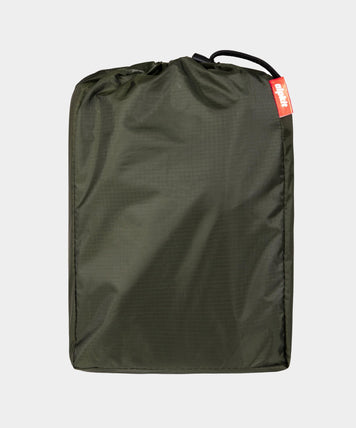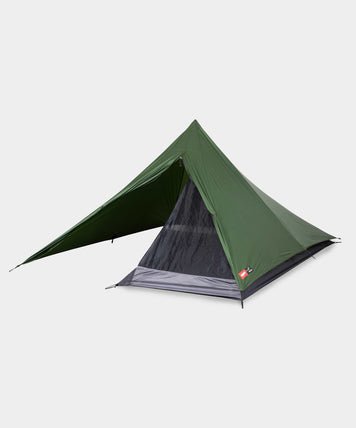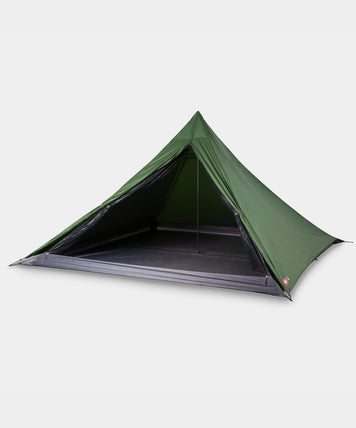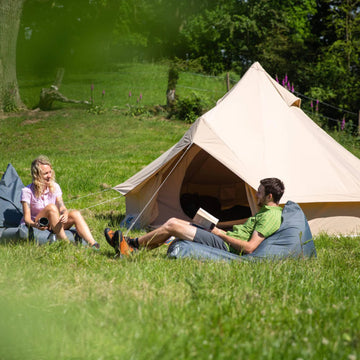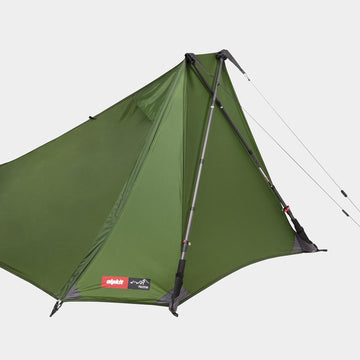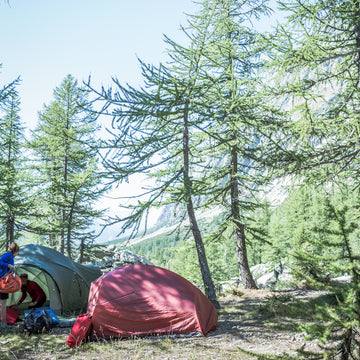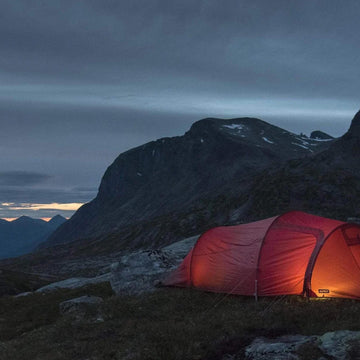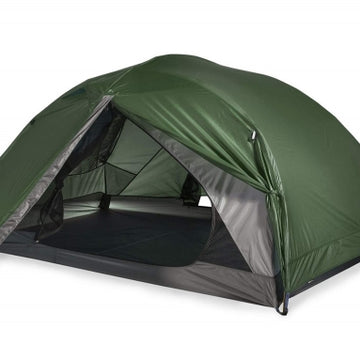
The essential guide to setting up a camping tarp. Read our 6 ways to set up a tarp when camping plus other top tarp tips.
Welcome to our guide on how to set up a tarp when camping. We'll explain 6 ways you can pitch a tarp and how to stop rain collecting on your tarp.
A lightweight tarp is one of the most versatile and handy bits of camping equipment you can own. It’s lighter than a tent, goes up faster when you’re caught in an unexpected downpour and lets you sleep out in the wilderness.
The biggest tip we can give you for pitching your tarp is practice, practice, practice! That way it won't matter what the weather's doing or where you are, you'll have a secure and cosy shelter up in no time.
6 ways to pitch a camping tarp
-
Plough Point Shelter
A fast and light shelter using just 3 pegs, some cord, and your trekking pole. -
Continuous Ridge Line
A classic shelter design, especially great for using with a hammock. -
The Reflect Wedge
Set up shelter using your bike, great for when there's a lack of natural features. -
Buried Sand Bags
Stay cool on the beach and turn your tarp into a beach shelter, no pegs needed! -
Kayak Bivvy
Create quick attachments to paddles, walking poles or anything really! -
Van Attachment
Makes an awning or extra living space for your camper van.


1. Plough Point Shelter
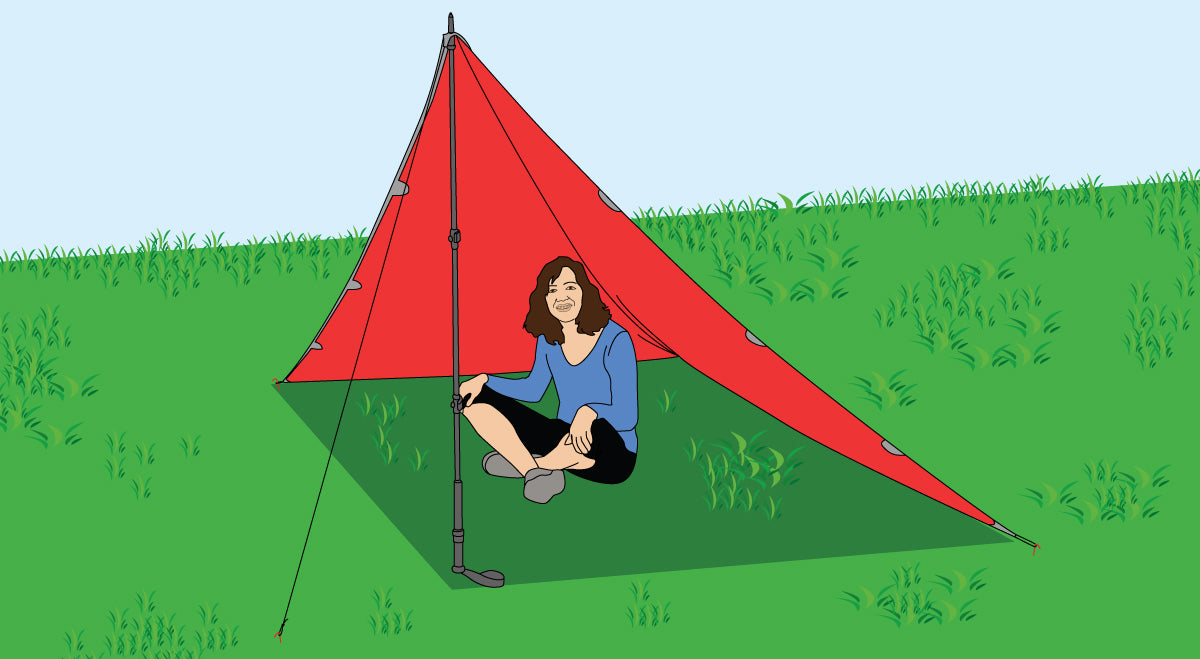
Why we like it
- Bucket loads of headroom (especially with a CarbonLong trekking pole)
- Really quick to set up
- Minimal kit required
Step 1:
Tie a cord to one of the corner tie down loops.
Step 2:
Lie the tarp flat on the ground where you want it and peg out the other three corners.
Step 3:
Raise the fourth corner using your trekking pole. Insert the pole tip into the rig point and tension by pegging out the cord that you tied on earlier. A longer pole (like the CarbonLong Single trekking pole) gives you more headroom.


Pro tip:
Pitch away from the wind for the best protection from the elements.
Continuous Ridge Line

Why we like it
- A classic pitching technique
- Super simple if you have a tarp with riser attachment points
- Uses minimal hardware
- Fits nicely over a hammock
Step 1:
Home prep - you can prepare your tarp at home by threading your line through any ridge risers you may have on your tarp. Attach a clipper to one end of the line and tie a prussik knot about halfway along the line with another clipper attached to it (There are plenty of videos online showing this knot). Now pack your tarp into a stuff-bag trying to leave the 2 clippers hanging out the top for a swift set up.

Step 2:
Find two trees that have enough room between them to pitch your tarp and choose what height you would like it. Run the clipper (without the prussik) around the first tree and clip it back through the ridgeline and attach it to the centre point of your tarp.
Step 3:
Now work your way along the ridgeline to the other end of your tarp, slide the prussik knot along the line so you have enough line to wrap it around the second tree and clip it into the centre point of this side of the tarp. Pull the prussik knot towards the tree to tighten.
Step 4:
Work the line around the trees to slide the tarp left or right to position it over your camp or hammock, then attach guys to each corner of your tarp and peg them out.
The Reflect Wedge

Why we like it
- Ideal for lightweight bikepacking with a tarp
- It’s quick and easy to setup - requiring little equipment, a small area and no natural features
- It provides wind shelter from two directions
- You can light your camping stove just outside.
Step 1:
Peg down the long edge of your tarp.
Step 2:
Remove your front wheel.
Step 3:
Create a ridge line from corner to corner. Tie a length of cord to the corner you wish to lift, secure it to the seat post or saddle of your bike and peg out. Your bike should be at approximately 90º to this ridge line. The illustration below shows the setup from above.

Step 4:
Peg down the last corner making the tarp taught(ish)
Step 5:
Attach a long loop of cord to two lifter points, wrap this around your wheel, pull tight and peg out.
Pro tip
This set up can be replicated with two walking poles in place of a bike
Buried Sand Bags

Why we like it
- Stay cool on the beach
- No need for pegs
- Creates shade in open beach areas
Step 1:
Attach lengths of cord to the tarp at the leading corners and at the lifter tabs halfway along the sides. Loop around the top of your sticks and down to the sand.
Step 2:
Fill some dry bags with sand and attach the cord.
Step 3:
Scoop out a hole in the sand and bury the bag. You could also bury a stick (this also works on snow).
Pro tip
Quickly attach a cord to your Rig Tarp with our Clipper accessory carabiners.
Kayak Bivvy

Why we like it
- Minimal extra equipment needed
- Utilises the Rig tarp’s stuff sack
- Can be pitched on the beach without pegs
Step 1:
Place your stuff bag over the top of the paddle.
Step 2:
Pull the drawcord tight around the paddle blade.
Step 3:
Attach a clipper to the end of the drawcord and clip on to any of the Rigs attachment points.
Step 4:
Peg out your paddle using a cord.
Pro tip
You can Larks foot the stuff bag’s drawcord around the webbing loops that cover the tarp, eliminating the need for a Clipper.
Van Attachment

Why we like it
- Simple trick for extending your living area
- Create a quick shelter, awning, or changing room.
Step 1:
Pass a piece of cord through an attachment point.
Step 2:
Tie a big double overhand knot in the cord.
Step 3:
Trap the cord in your vehicle door.
Pro tip
If you have a set of F171 walking poles use these in the opposite corners to prop the tarp up.
Leaving this set up over a long period in bad weather can cause water to seep along the cord and ‘drip’ into your vehicle.
How do I stop water collecting on my tarp?
You can stop water collecting on your tarp in several ways. Here are our top tips:
-
Pitch two corners of your tarp higher
If you pitch your tarp at an angle with one side higher than the other the rain will run off and have nowhere to collect. -
Setup your tarp with a Ridgeline
Setup your tarp using our Ridgeline technique which creates a central high point in your tarp. The water simply runs off either side of this line. You can also use a branch as the ridge line if you haven't set up your tarp earlier. -
Pitch your tarp taught
Making sure you've got a taught surface to your tarp helps to stop water collecting. Water tends to collect where your tarp sags so if you've pulled it tight this will help run off. Make sure you don't over tighten the cords as this might cause your tarp to fray or rip.
Camping Tarps





